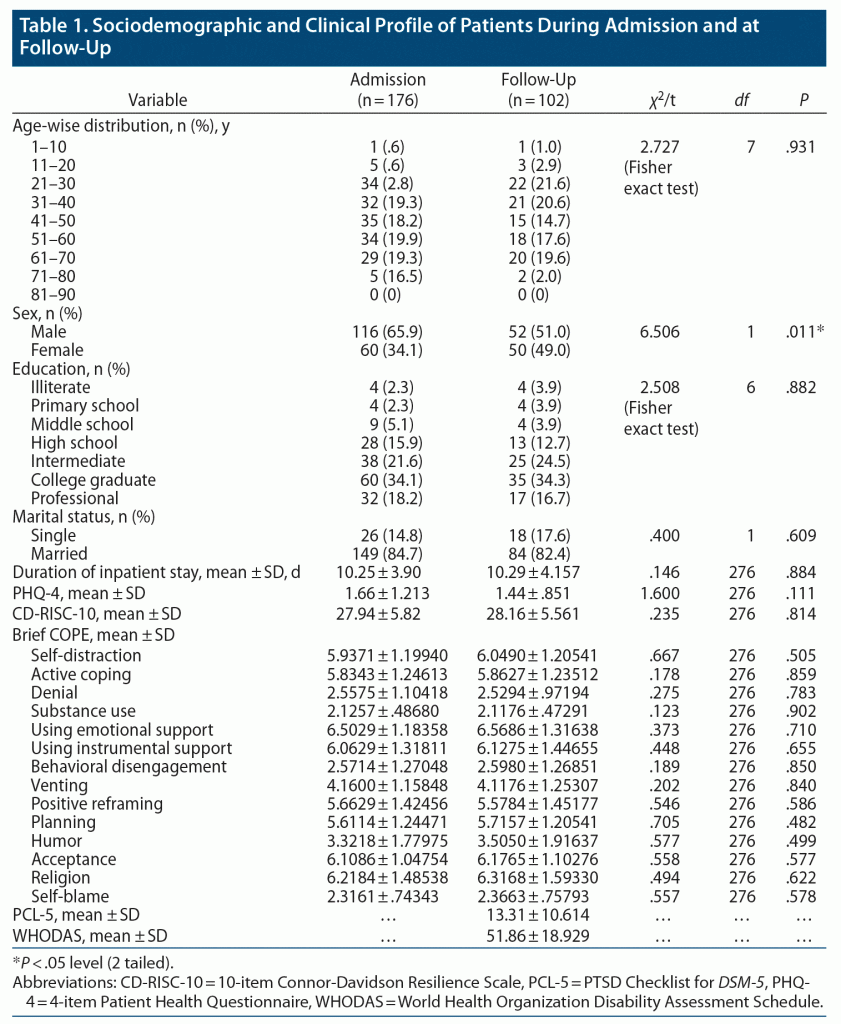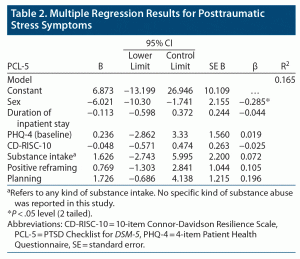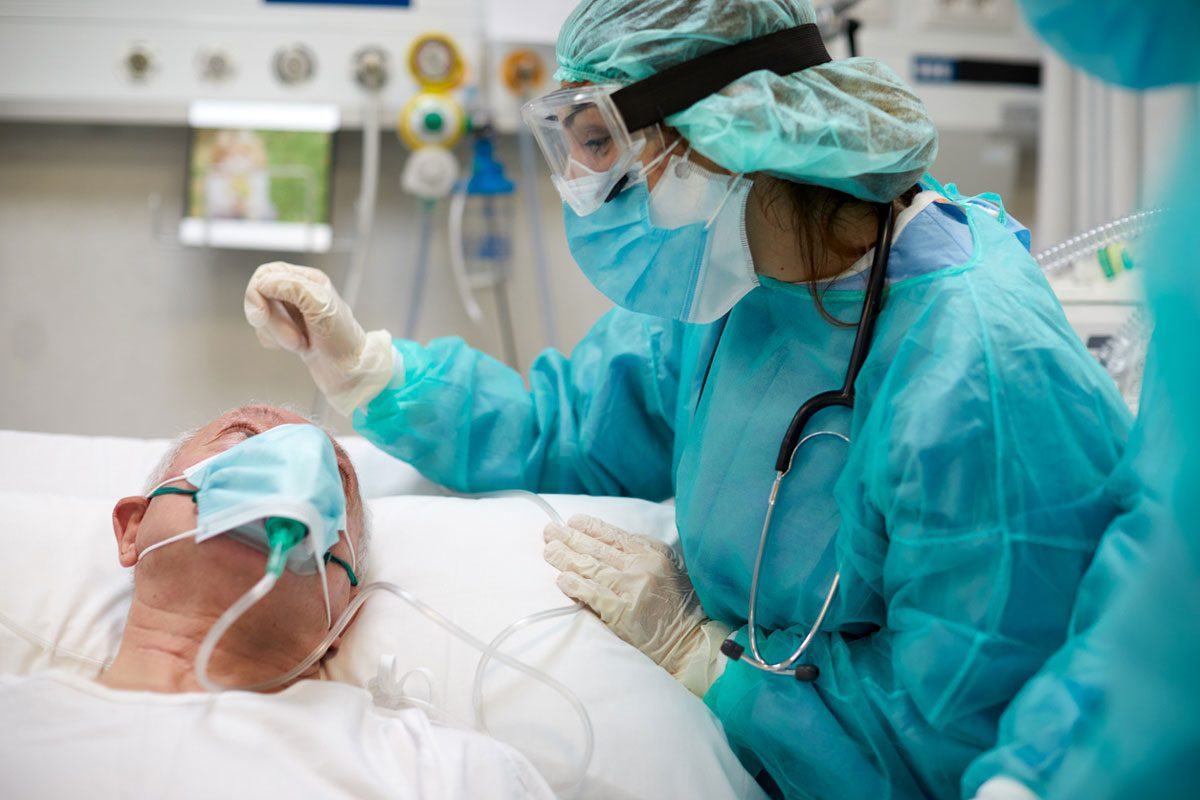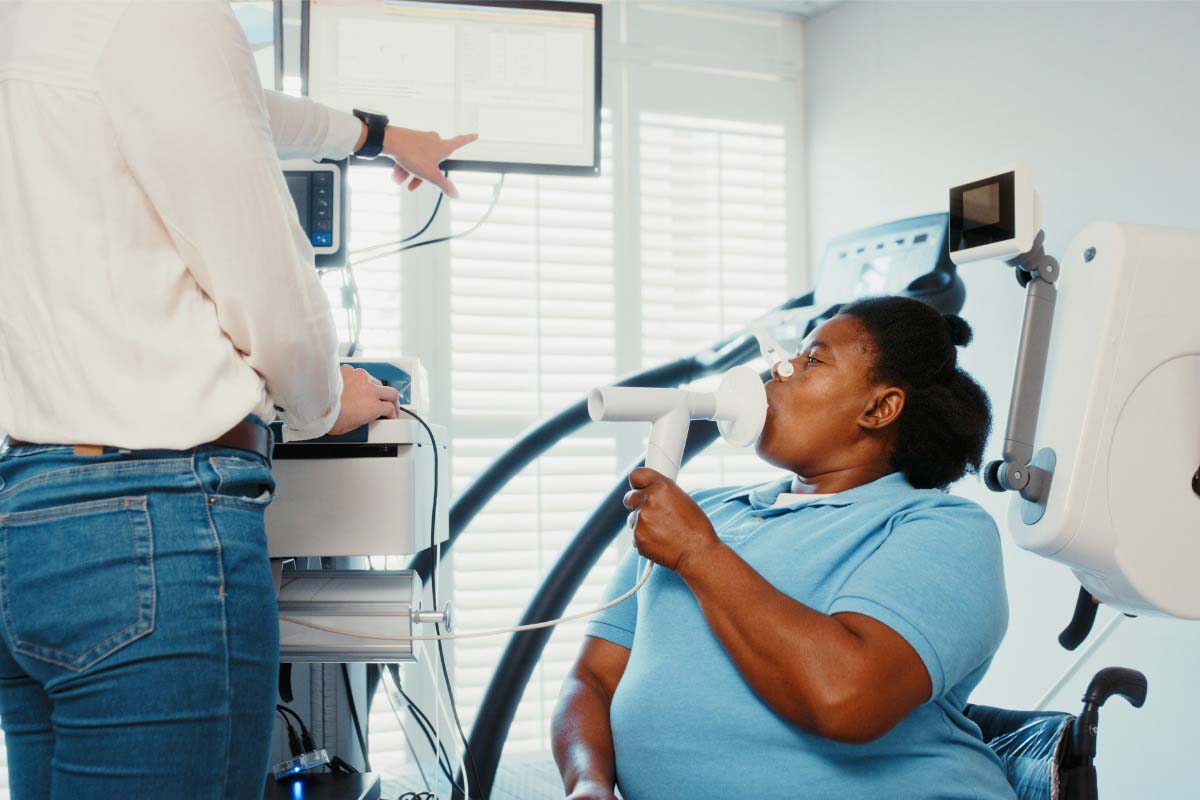ABSTRACT
Objective: To assess psychological resilience, coping, and related psychological distress in admitted COVID-19 patients. Predictors of subsequent development of posttraumatic stress symptoms (PTSS) and disability were also studied.
Methods: Stable inpatients with COVID-19 (aged > 18 years with mild symptoms) admitted to a tertiary care hospital from April 2020 to December 2020 were recruited for the study. During admission, the patients were assessed for resilience, coping, and psychological distress using the 10-item Connor-Davidson Resilience Scale (CD-RISC-10), Brief COPE (Coping Orientation to Problems Experienced), and 4-item Patient Health Questionnaire (PHQ-4). Similarly, they were assessed at 4 weeks after discharge using the PTSD Checklist for DSM-5 and World Health Organization Disability Assessment Schedule.
Results: A total of 176 patients were recruited for the study and assessed during their admission, and 102 were reassessed during follow-up. Of the patients, 17.6% during admission and 58.8% at follow-up had significant psychological distress (PHQ-4 score > 2). The mean ± SD CD-RISC-10 score was 27.94 ± 5.82. The most used coping strategies were emotional support, religion, and acceptance. Increased resilience was associated with better education (rs[100] = 0.265, P = .007), less psychological distress (r[100] = –0.596, P = .001), and healthy coping strategies. PHQ-4, PCL-5, and disability scores at follow-up were positively correlated (Pearson correlation). The multiple regression model statistically significantly predicted PTSS (F7, 94 = 2.660, P < .015, adjusted R2 = 0.103).
Conclusions: COVID-19 patients with better resilience are associated with reduced psychological distress. Better resilient traits and reduced psychological distress may prevent ensuing PTSS and disability.
Prim Care Companion CNS Disord 2022;24(3):21m03230
To cite: Miglani M, Upadhyay P, Mahajan R, et al. Psychological resilience, coping, and distress in admitted patients with COVID-19 infection. Prim Care Companion CNS Disord. 2022;24(3):21m03230.
To share: https://doi.org/10.4088/PCC.21m03230
© Copyright 2022 Physicians Postgraduate Press, Inc.
aDepartment of Psychiatry, Dayanand Medical College and Hospital, Tagore Nagar, Ludhiana
bDepartment of Clinical Psychology, Dayanand Medical College and Hospital, Tagore Nagar, Ludhiana
cDepartment of Medicine, Dayanand Medical College and Hospital, Tagore Nagar, Ludhiana
dDepartment of Cardiology, Hero DMC Heart Institute, Tagore Nagar, Ludhiana
eDepartment of Psychiatry, Shri Guru Ram Rai Institute of Medical and Health Sciences, Uttarakhand, India
fDepartment of Psychiatry, All India Institute of Medical Sciences, Telangana, India
*Corresponding author: Shobit Garg, MD, DPM, Department of Psychiatry, Shri Guru Ram Rai Institute of Medical and Health Sciences, Patel Nagar, Dehradun, Uttarakhand, India 248001 ([email protected]).
Since the epidemic outbreak of coronavirus disease 2019 (COVID-19), more than 275 million people have been infected and more than 5 million have died worldwide.1 Specifically, in India (worse hit by the second wave) there have been more than 34 million people infected with the virus and approximately 470,000 deaths to date.1 COVID-19 has well-known physical health consequences, ranging from mild flu-like symptoms to severe respiratory compromise and death. A positive COVID-19 test exposes individuals to distressing situations such as isolation, loneliness, quarantine (akin to cabin fever),2 and stigma.3 Lack of hospital beds, oxygen, and medications during the second wave of COVID-19 added to the cumulative distress in India. This cumulative burden often results in adverse psychological outcomes in COVID-19 patients.4,5 The most common adverse outcomes include low well-being, depression, anxiety, poor sleep quality, and posttraumatic stress symptoms (PTSS).6 These “exposure and outcome” dynamics are moderated by several key factors, and one of the important key factors is resilience.7 Moreover, according to the European College of Neuropsychopharmacology,8 there is a pressing need to augment studies on resilience and allied coping skills to devise strategies to combat adverse outcomes.9 Recent literature has focused on the general population’s psychological resilience during the lockdown phase of the pandemic.10 Studies addressing resilience and allied coping skills in admitted COVID-positive patients are lacking.
The objective of this study was to assess psychological resilience, allied coping skills, and psychological distress of COVID-19 patients during hospital admission and short-term follow-up. An additional objective was to assess the predictors of subsequent PTSS and disability in the follow-up sample.
METHODS
Study Design
This was a hospital-based follow-up study of patients admitted to a tertiary care hospital with COVID-19 infection from April 2020 to December 2020. Recruited participants were assessed for resilience, coping, and presence of psychological distress (depression or anxiety). The same cohort was followed up 1 month after discharge. Participants were assessed after discharge for PTSS and disability level.
Subjects
Consecutive patients admitted to the hospital were recruited after screening for the inclusion/exclusion criteria. Eligibility criteria were (1) age > 18 years, (2) admitted due to COVID-19 viral infection with documented RT-PCR positive report, and (3) designated as having “mild” illness (ie, those presenting with fever and with uncomplicated upper respiratory tract illness).11 Exclusion criteria were (1) those who were medically unstable (hypoxic, on ventilation support, or had delirium) or unable to comprehend (or cooperate) and respond to the questionnaires, (2) those with a history of any mental disorders, and (3) and those who did not provide informed consent.
Assessments
During admission, patients were assessed for the presence of psychological distress (depression or anxiety) with the 4-item Patient Health Questionnaire (PHQ-4).12 Subsequently, all participants were assessed for coping and resilience with the 10-item Connor-Davidson Resilience Scale (CD-RISC-10)13 and Brief COPE (Coping Orientation to Problems Experienced),14 respectively. The CD-RISC has been widely used in different populations (including psychiatric patients, adolescents, and the elderly) and has shown good reliability and validity.13,15 Item responses range from 0 (“not true at all”) to 4 (“true nearly all of the time”), and higher total scores reflect greater resilience.13 The Brief COPE, an abbreviated form of the COPE Inventory, is a short 28-item questionnaire that measures 14 coping reactions/strategies. These items include (1) active coping, (2) planning, (3) positive reframing, (4) acceptance, (5) humor, (6) religion, (7) using emotional support, (8) using instrumental support, (9) self-distraction, (10) denial, (11) venting, (12) substance use, (13) behavioral disengagement, and (14) self-blame. Each item is rated on a 4-point Likert scale, with higher scores indicating increased usage of that specific coping strategy. The Brief COPE has been shown to have good internal reliability.14
Among patients who were assessed during admission, those who followed up 1 month after discharge were reassessed for any PTSS and disability level by the PTSD Checklist for DSM-5 (PCL-5)16 with criterion A and the World Health Organization Disability Assessment Schedule (WHODAS 2.0),17 respectively.
The PCL-5 is a 20-item self-report measure that assesses the presence and severity of posttraumatic stress disorder (PTSD) symptoms. Each item is rated on a 4-point Likert scale, and scores of each item are summed (range, 0–80).16 The WHODAS 2.0 is a generic assessment instrument that can measure disability in clinical practice. It captures the level of functioning in 6 domains of life: (1) cognition, (2) mobility, (3) self-care, (4) getting along, (5) life activities, and (6) participation/joining in the community. Scores assigned to each of the items (none: 1, mild: 2, moderate: 3, severe: 4, and extreme: 5) are summed. Higher scores suggest greater disability.17
Statistical Analysis
Study data were analyzed using SPSS version 22 (IBM, Armonk, New York). Statistical testing was 2-sided with 5% as a criterion for significance. Description of sample characteristics (during admission and follow-up) was done using descriptive statistics (ie, percentage, mean, and standard deviation). Mean PHQ-4 scores were calculated during admission (PHQ-4A) and follow-up (PHQ-4B). Group differences between admission and follow-up sample characteristics were examined with an independent t test and χ2 test (wherever applicable). Correlation analysis for association was conducted within and between characteristics at admission and follow-up using Pearson and Spearman ρ correlations (wherever applicable). Multiple regression was also run to predict PTSS and disability (in the follow-up sample) developed from the sex perspective, duration of inpatient stay, PHQ-4A score, resilience scores, and 3 coping dimensions (substance intake, positive reframing, and planning; selected as significantly more of the post-discharge patients have more psychological distress). A PHQ-4 score > 2 was used as a cutoff to determine the presence of psychological distress (depression or anxiety).12
Ethical Consideration
The study was approved by the hospital ethics committee. All patients provided informed consent before participating in the study.
RESULTS
A total of 176 patients were recruited for the study and assessed during their admission, and 102 were reassessed during follow-up. The reason for the decline in the follow-up sample was largely due to the inability to establish contact with the patients after discharge.
Sociodemographic and Clinical Characteristics
When admission and follow-up sample characteristics were compared excluding sex distribution (χ21, 278 = 6.506, P < .05), none of the sociodemographic and clinical parameters were significantly different (Table 1).
During admission. Of 176 admitted patients who were interviewed, 116 (65.9%) were men and 60 (34.2%) were women. Only 31 (17.6%) admitted patients had significant psychological distress (PHQ > 2, men > women). The highest age-wise distribution was for the age range 41–50 years. With regard to education, the majority were college graduates (34.2%). Mean ± SD PHQ-4A and CD-RISC-10 whole sample scores during admission were 1.66 ± 1.213 and 27.94 ± 5.82, respectively. For the Brief COPE, using emotional support had the highest mean ± SD value of 6.50 ± 1.18, followed by receiving help through religion (6.21 ± 1.48) and using acceptance (6.10 ± 1.04) as means of coping. Strategies like substance use, self-blame, and denial as means of coping were endorsed the least, with the lowest mean ± SD scores of 2.1257 ± 0.48, 2.3161 ± 0.74, and 2.5575 ± 1.10, respectively (see Table 1).
Follow-up. Of 176 admitted patients, a total of 102 patients could be followed up and interviewed 1 month after discharge. Of 102 patients, 52 (51%) were men and 50 (49%) were women. Sixty (58.8%) patients in the follow-up cohort had significant psychological distress (PHQ > 2, men > women). The highest age-wise distribution was for the age range 21–30 years, which was closely followed by 31–40 years. Of the follow-up sample, the majority were college graduates (34.3%). The mean ± SD PHQ-4B, PCL-5, and WHODAS 2.0 scores of the follow-up sample were 3.32 ± 2.633, 13.31 ± 10.614, and 51.86 ± 18.929, respectively. On the Brief COPE, using emotional support again had the highest mean ± SD value of 6.57 ± 1.32, followed by receiving help through religion (mean = 6.32 ± 1.59) and using acceptance (mean = 6.18 ± 1.10) as ways of coping. Similarly, strategies like substance use, self-blame, and denial as means of coping were endorsed the least (see Table 1).
Associations at Follow-Up
Sociodemographic data. The result of the Spearman correlation suggests that there was a significant positive correlation between male sex and PHQ-4A scores (rs[100] = 0.245, P = .013) and between education and CD-RISC scores (rs[100] = 0.265, P = .007). Also, a significant negative association was found between female sex and PCL-5 scores (rs[100] = 0.283, P = .004). The result of the Pearson correlation suggests that there was a significant positive correlation between age and disability scores (r[100] = 0.212, P = .032).
Clinical variables. The result of the Pearson correlation suggests that there was a significant negative correlation between PHQ-4A and CD-RISC scores (r[100] = –0.596, P = .001). The significant positive correlation was found between PHQ-4B and PCL-5 (r[100] = 0.666, P = .001) and disability scores (r[100] = 0.411, P = .001). Also, the result of the Pearson correlation suggests that there was a significant positive correlation between PCL-5 and disability scores (r[100] = 0.338, P = .001). CD-RISC scores had a significant positive correlation between various coping strategies like active coping (r[100] = 0.278, P = .005), self-distraction (r[100] = 0.604, P = .001), use of emotional support (r[100] = 0.268, P = .007), use of instrumental support (r[100] = 0.305, P = .002), behavioral disengagement (r[100] = 0.255, P = .010), planning (r[100] = 0.451, P = .001), positive reframing (r[100] = 0.522, P = .001), acceptance (r[100] = 0.510, P = .001), and humor (r[100] = 0.508, P = .001). Significant negative correlations were found between PHQ-4A and active coping (r[100] = –0.281, P = .004), self-distraction (r[100] = –0.205, P = .039), positive reframing (r[100] = –0.249, P = .012), and acceptance (r[100] = –0.284, P = .004).
Prediction of PTSS and Disability
A multiple regression model was run to study the relationships of PTSS and disability, respectively. Factors entered in the model were sex, duration of inpatient stay, PHQ-4A score, resilience scores, and 3 coping dimensions (substance intake, positive reframing, planning). The multiple regression model statistically significantly predicted PTSS (F7, 94 = 2.660, P < .015, adjusted R2 = 0.103). But of all factors, sex significantly contributed to the prediction (P < .05). Regression coefficients and standard errors are provided in Table 2. Unlike PTSS, this model could not significantly predict disability (F7, 94 = 1.370, P < .227, adjusted R2 = 0.093).
DISCUSSION
The current study is among the first to assess resilience, allied coping skills, and associated psychological distress in COVID-19 patients admitted to the hospital. Also, this study assessed the variables that could predict the presence of PTSS and disability at follow-up.
Admitted COVID-19 patients were predominantly male and had graduated from college. During admission, around one-fifth of patients (males > females) had psychological distress. However, the proportion (males > females) increased to more than 50% with significant psychological distress in the follow-up cohort. Increased resilience has been associated with better education, less psychological distress, and healthy coping strategies. The most used coping strategies by the follow-up cohort were emotional support, religion, and acceptance. Female sex was the most significant predictor of ensuing PTSS due to COVID-19 at follow-up.
Depression is known to be more prevalent in females,18 but predominant sex representation among COVID-19 sufferers is not clear.19–21 Our study found a positive association between education and resilience and concurs with earlier studies wherein better education was associated with higher levels of resilience.22 On the other hand, higher education has been reported to hinder resilience as per the ecological survey-based studies among the general population,23 which contrasts with our study findings. These discrepancies could be due to the different reporting platforms.
Mean resilience scores (CD-RISC-10 score: 27.94 ± 5.82) in our study population are comparable with those reported in the general population15 and among World War II survivors.24 Enhanced resilience is related to less COVID-19 anxiety or distress and is replicated by other studies.12,23,25 Killgore et al10 reported similar findings in US adults during the initial weeks of lockdown. They studied the association of higher depression, anxiety scores, and suicidal ideation with lower CD-RISC scores. Higher resilience is associated with the use of active coping, self-distraction, use of emotional and instrumental support, behavioral disengagement, planning, positive reframing, acceptance, and humor as coping strategies. Park et al,26 in a population-based survey during quarantine, reported that coping strategies used to manage stress were distraction and active coping, which is in line with our study findings. Chew et al27 recently conducted a narrative synthesis of coping responses in the general population during past infectious disease outbreaks. They found that people employed more emotion and problem-focused coping. One explanation for distress despite using problem-focused coping in our study sample could be due to the “more coping–more panic” cycle described by Huang and colleagues.28 Overall, emotional support, religion, and acceptance were the most common coping strategies used by our sample, which is understandable given that India is a collectivistic society and multireligious country.
At follow-up 4 weeks after discharge, a higher proportion of COVID-19 patients (> 50%) had psychological distress compared to when they were assessed during admission. This higher proportion could be due to the increased reporting by those suffering from depression or anxiety. Also, psychological distress (PHQ-4B) was associated with significant PTSS and disability levels. As per a recent online survey of COVID-19 survivors,29 elevated rates of PTSD symptoms were identified in those requiring hospital admission without ventilation (effect size = 0.234, P = .0064). Studies30 have found associations of high levels of COVID-19–specific worry and low distress tolerance with PTSD similar to our study.
The multiple regression model in the current study statistically significantly predicted PTSS. Among all the factors, female sex significantly contributed to the prediction. The female sex preponderance as a predictor of PTSD in COVID-19 has been replicated in prior studies.30,31
An important limitation of our study is the recruitment of patients with only mild COVID symptoms. Follow-up psychological status has been strongly related to the presence of more severe symptoms. PTSD, for instance, has often been associated with intubation, severe hypoxia and related fear of death, and experience of being in the intensive care unit. Expectedly, the rates of psychological morbidity are likely to be an underestimate given the nature of our recruitment and therefore is a prominent weakness of our study. Another important limitation of our study is the significant dropout rate at follow-up, which was higher in men. This dropout rate may also be attributed to patients with milder illness not perceiving the need for reconsultation or reassessment. While the shorter follow-up period (4 weeks) limited the assessment of long-term consequences, the restricted age range limited the generalizability of the findings to teens and adolescents. Another limitation of the study is the defined duration of PTSS, which is < 1 month. Confounding effects of the supportive telecounseling session on PTSS and disability scores could be another limitation.
CONCLUSION
COVID-19 patients with better resilient traits and healthy coping skills are associated with reduced psychological distress. Better resilient traits and reduced psychological distress may prevent ensuing posttraumatic symptoms and disability. Bolstering of psychological resilience and coping skills should be a primary public health emphasis during the COVID-19 pandemic.
Submitted: December 26, 2021; accepted February 8, 2022.
Published online: May 5, 2022.
Relevant financial relationships: None.
Funding/support: None.
Acknowledgments: The authors thank interns Nuhar Thind, MBBS, and Aradhika Deswal, MBBS (both from Dayanand Medical College and Hospital, Tagore Nagar, Ludhiana), who contributed in data collection and data entry.
References (31)

- World Health Organization. WHO Coronavirus Disease (COVID-19) dashboard. WHO website. Accessed December 23, 2021. https://covid19.who.int/
- Stawicki SP, Jeanmonod R, Miller AC, et al. The 2019–2020 novel coronavirus (severe acute respiratory syndrome coronavirus 2) pandemic: a Joint American College of Academic International Medicine-World Academic Council of Emergency Medicine Multidisciplinary COVID-19 Working Group Consensus Paper. J Glob Infect Dis. 2020;12(2):47–93.
- Grover S, Sahoo S, Mehra A, et al. Psychological impact of COVID-19 lockdown: an online survey from India. Indian J Psychiatry. 2020;62(4):354–362. PubMed CrossRef
- Killgore WDS, Cloonan SA, Taylor EC, et al. Loneliness: a signature mental health concern in the era of COVID-19. Psychiatry Res. 2020;290:113117. PubMed CrossRef
- Janiri D, Carfì A, Kotzalidis GD, et al; Gemelli Against COVID-19 Post-Acute Care Study Group. Posttraumatic stress disorder in patients after severe COVID-19 infection. JAMA Psychiatry. 2021;78(5):567–569. PubMed CrossRef
- Vindegaard N, Benros ME. COVID-19 pandemic and mental health consequences: systematic review of the current evidence. Brain Behav Immun. 2020;89:531–542. PubMed CrossRef
- Kruk ME, Ling EJ, Bitton A, et al. Building resilient health systems: a proposal for a resilience index. BMJ. 2017;357:j2323. PubMed CrossRef
- Vinkers CH, van Amelsvoort T, Bisson JI, et al. Stress resilience during the coronavirus pandemic. Eur Neuropsychopharmacol. 2020;35:12–16. PubMed CrossRef
- Holmes EA, O’Connor RC, Perry VH, et al. Multidisciplinary research priorities for the COVID-19 pandemic: a call for action for mental health science. Lancet Psychiatry. 2020;7(6):547–560. PubMed CrossRef
- Killgore WDS, Taylor EC, Cloonan SA, et al. Psychological resilience during the COVID-19 lockdown. Psychiatry Res. 2020;291:113216. PubMed CrossRef
- Guidance document on appropriate management of suspect/confirmed cases of COVID-19. Ministry of Health & Family Welfare Directorate General of Health Services EMR Division website. Accessed April 15, 2020. https://www.mohfw.gov.in/pdf/FinalGuidanceonMangaementofCovidcasesversion2.pdf
- Kroenke K, Spitzer RL, Williams JB, et al. An ultra-brief screening scale for anxiety and depression: the PHQ-4. Psychosomatics. 2009;50(6):613–621. PubMed
- Connor KM, Davidson JR. Development of a new resilience scale: the Connor-Davidson Resilience Scale (CD-RISC). Depress Anxiety. 2003;18(2):76–82. PubMed CrossRef
- Carver CS. You want to measure coping but your protocol’ too long: consider the Brief COPE. Int J Behav Med. 1997;4(1):92–100. PubMed CrossRef
- Campbell-Sills L, Stein MB. Psychometric analysis and refinement of the Connor-Davidson Resilience Scale (CD-RISC): validation of a 10-item measure of resilience. J Trauma Stress. 2007;20(6):1019–1028. PubMed CrossRef
- Weathers FW, Litz BT, Keane TM, et al. The PTSD Checklist for DSM-5 (PCL-5). National Center for PTSD website. Accessed March 31, 2022. http://www.ptsd.va.gov
- Federici S, Bracalenti M, Meloni F, et al. World Health Organization Disability Assessment Schedule 2.0: an international systematic review. Disabil Rehabil. 2017;39(23):2347–2380. PubMed CrossRef
- Albert PR. Why is depression more prevalent in women? J Psychiatry Neurosci. 2015;40(4):219–221. PubMed CrossRef
- Kamberi F, Jaho J, Mechili EA, et al. Effect of Covid-19 pandemic on mental health among Albanian people residing in the country and abroad: implications for mental care. Arch Psychiatr Nurs. 2020;34(6):507–512. PubMed CrossRef
- Hurissi E, Abu-jabir E, Mohammed A, et al. Assessment of new-onset depression and anxiety associated with COVID-19. Middle East Curr Psychiatry. 2021;28(1):33. CrossRef
- Siewe Fodjo JN, Ngarka L, Njamnshi WY, et al. Fear and depression during the COVID-19 outbreak in Cameroon: a nation-wide observational study. BMC Psychiatry. 2021;21(1):356. PubMed CrossRef
- Frankenberg E, Sikoki B, Sumantri C, et al. Education, vulnerability, and resilience after a natural disaster. Ecol Soc. 2013;18(2):16. PubMed CrossRef
- Panzeri A, Bertamini M, Butter S, et al. Factors impacting resilience as a result of exposure to COVID-19: the ecological resilience model. PLoS One. 2021;16(8):e0256041. PubMed CrossRef
- Tran US, Glück TM, Lueger-Schuster B. Influence of personal and environmental factors on mental health in a sample of Austrian survivors of World War II with regard to PTSD: is it resilience? BMC Psychiatry. 2013;13(1):47. PubMed CrossRef
- Riehm KE, Brenneke SG, Adams LB, et al. Association between psychological resilience and changes in mental distress during the COVID-19 pandemic. J Affect Disord. 2021;282:381–385. PubMed CrossRef
- Park CL, Russell BS, Fendrich M, et al. Americans’ COVID-19 stress, coping, and adherence to CDC guidelines. J Gen Intern Med. 2020;35(8):2296–2303. PubMed CrossRef
- Chew QH, Wei KC, Vasoo S, et al. Narrative synthesis of psychological and coping responses towards emerging infectious disease outbreaks in the general population: practical considerations for the COVID-19 pandemic. Singapore Med J. 2020;61(7):350–356. PubMed CrossRef
- Huang L, Lei W, Xu F, et al. Emotional responses and coping strategies in nurses and nursing students during COVID-19 outbreak: a comparative study. PLoS One. 2020;15(8):e0237303. PubMed CrossRef
- Chamberlain SR, Grant JE, Trender W, et al. Posttraumatic stress disorder symptoms in COVID-19 survivors: online population survey. BJPsych Open. 2021;7(2):e47. PubMed CrossRef
- Liu CH, Zhang E, Wong GTF, et al. Factors associated with depression, anxiety, and PTSD symptomatology during the COVID-19 pandemic: clinical implications for US young adult mental health. Psychiatry Res. 2020;290:113172. PubMed CrossRef
- Rogers JP, Chesney E, Oliver D, et al. Psychiatric and neuropsychiatric presentations associated with severe coronavirus infections: a systematic review and meta-analysis with comparison to the COVID-19 pandemic. Lancet Psychiatry. 2020;7(7):611–627. PubMed CrossRef
Please sign in or purchase this PDF for $40.







